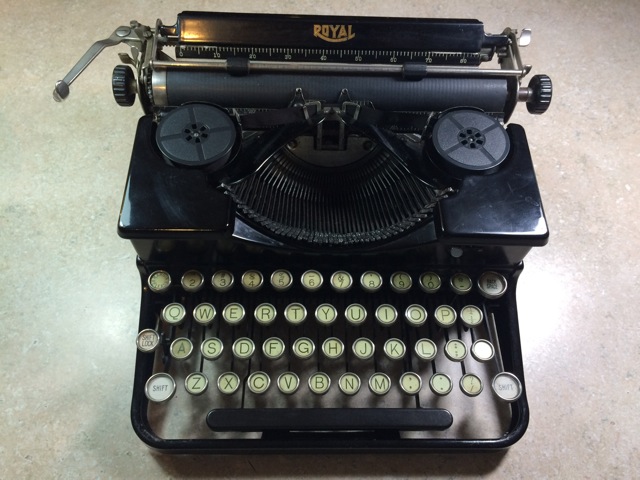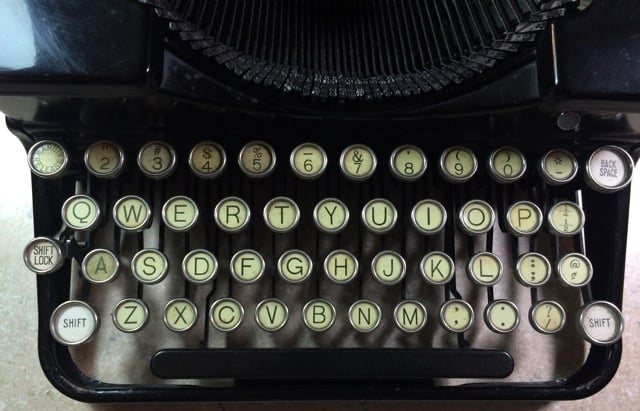You have /5 articles left.
Sign up for a free account or log in.
Last fall, I brought my 1918 Royal manual typewriter into my Communicating Science to the Public class at MIT. I kept a box over the machine and unveiled it at the start of class as though revealing a new car. Oohs and ahs followed. “That’s so cool!” one student declared. Every one of the 18 first-year undergraduates could not take their eyes off the typewriter. Many of them were smiling. It was 9:30 in the morning, and they seemed surprisingly happy, curious and ready to learn.

(What I love most about manual typewriters is that they cannot be turned off. This 1918 Royal has been turned on and ready to write for nearly 100 years.)
I asked the students to get up from their desks to get a closer look at the typewriter. “Go ahead, you can type something if you want,” I said as they circled around the machine. One brave young man stepped forward and typed the word “hello.”
“Wow, this is harder than a computer,” he said while typing. Yep, you’ve got to put some muscle into manual typewriters and really strike down on each key, and if you type too fast the keys get stuck.
Many of the students, I assumed, were wondering why the heck their teacher brought an antique machine into a class where we read and write about the latest scientific and technological advancements. Fortunately, a typewriter can serve as a springboard for kinesthetic learning experiences, and here are two activities that emerged that particular morning.
How Do We Communicate Enthusiasm?
I asked the students to look closely at the keyboard. The familiar QWERTY layout alleviated some of the strangeness of the machine; however, as with all typewriters built before the 1970s, a certain punctuation mark was absent from the keys. I asked the students to identify the missing punctuation. See if you can spot it:

Did you find it?
It’s the exclamation point!
I challenged the students to imagine they were writing an article with this typewriter, and they really wanted to include an exclamation point at the end of a sentence. I asked them to work together as a team and generate as many ways to make an exclamation point as possible.
“How about typing a lowercase ‘l’ and then hit the backspace and then type a period?” one student asked. “Go ahead and try it,” I said. She pressed the keys. Dissatisfied with the outcome of this first attempt, another student made a suggestion: “How about typing a semicolon, then hitting the backspace, then adding an apostrophe?” “Give it a try,” I said. This pattern of trial and error continued for a couple of minutes: a student would approach the typewriter to test her ideas using different combinations of keys as her classmates waited to see whether the plan would work. They chuckled at each other’s efforts. Interestingly, none of them were satisfied with any of the aspiring exclamation points. They wanted the real thing, clean and recognizable, but struggled to create it using the available keys.
We took a break from the typewriter, and I asked them to take out their cell phones. “How could you communicate enthusiasm to someone using your smartphone keyboard?” Answers poured forth: there is an exclamation point readily available, plus many emojis to choose from. “What do you think the keyboard of the future will look like?” I asked. “Entirely emojis!” one student answered.
The author F. Scott Fitzgerald once likened an exclamation point at the end of a sentence to a person laughing at his own joke. In other words, the exclamation point implies a forced rather than generative response in an audience. I asked the students, “When it comes to science articles written for the public, rather than putting an exclamation point or emoji at the end of every sentence, how else can we communicate our interest and generate enthusiasm for the topic?” To help ground the class discussion in the reality of our work, students returned to their seats to examine their own article drafts. In small groups, they tried to identify and share instances, if any, in which they communicated excitement through words that might inspire a sense of wonder and enthusiasm in their reader.
Individual Agency in the Daunting Research and Writing Process
Something else happened during the typewriter exercise. After struggling to create a satisfactory exclamation point using the typewriter keys, the students grew quiet. No one touched the typewriter, and the novelty of the exercise seemed to be wearing thin.
“Wait,” said one student. She had noticed a pen next to the typewriter. “Could I just draw an exclamation point?” Interestingly, I had done this exercise twice before in other classes, and no student had ever asked this question, even though I had intentionally placed a pen beside the typewriter each time. “I don’t see why not,” I replied. “Give it a try.” She picked up the pen and drew an exclamation point on the paper. The students laughed, and some even clapped.
When I asked the students to create an exclamation point, they implicitly imposed the false constraint that the only available resource was the typewriter itself. After all, the typewriter seems complete. The machine was built by professionals and seems to have all of the necessary parts to communicate through writing. Yet human agency is still required to operate and maintain the typewriter, and most importantly, to produce writing that impacts an audience. The remarkable student who reached for the pen recognized her own body and mind as resources for problem solving and participation.
The hand-drawn exclamation point led to a discussion of the role of human agency when confronting the challenge of producing original texts as a college student. When I was an undergraduate, I remember reading published journals, magazines and books and thinking, “How can I contribute anything meaningful to this field? Why should I even bother trying to write an essay on this topic when so much has already been written? I’m only a student.”
As novices who are expected to understand and participate in the intellectual territory of experts, students often experience impostor syndrome and may question whether their writing could (or should) be more than a patchwork of citations and paraphrases. I asked the students to try rereading a few of the articles they had read for homework through a new lens -- to identify the writer’s chosen scope, particular use of metaphor, organization of ideas, connections of seemingly unrelated information and instances in which he or she related to the subject through personal experience. That led to a discussion of the rhetorical choices that represent an author’s original perspective and approach to communicating about a range of topics, ranging from the behavior of ants to the formation of black holes.
Why Bring a Typewriter?
To state the obvious: I’m a big fan of typewriters. Although I teach at MIT, I’m a Luddite in my personal life. I enjoy the musicality of writing on a manual typewriter and how it’s always sitting there ready to be used without needing to be plugged in or have its battery charged. The inability to delete, cut and paste text propels me to ignore my inner critic and plow ahead with unpolished thoughts in the early stages of ideation.
I have no doubt that the in-class discussions described above could have occurred without the prop of a 1918 Royal manual typewriter. However, the physical presence of the antique machine launched an out-of-the-ordinary kinesthetic learning experience for students.
Although imperfect and at times unpredictable, the praxis of experiential learning is powerful. In my Communicating Science to the Public class, students could see how excited I was to show them the typewriter, which inspired them to interact with the machine and one another in new ways, to smile and move physically more than they would otherwise in a classroom, and to invest more of themselves in the subsequent discussions.
I’d love to learn from you, readers of Inside Higher Ed, about the physical objects that have catapulted meaningful pedagogical moments in your classroom. Feel free to share in the comment space below.
We can’t always bring our personal hobbies and interests into the classroom, but I think it feels good when we can. As teachers, we model for students how to engage critically with a subject, how to inspire learning, how to interact with others and even how to be excited about something.




